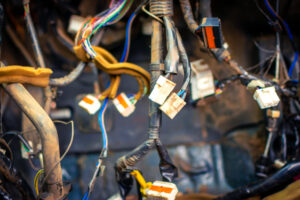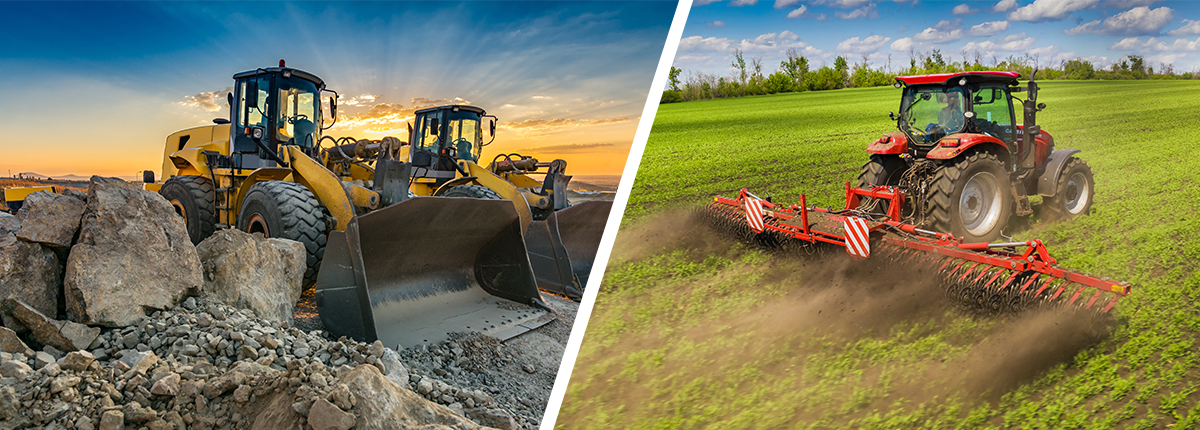Correct, safe wiring and accessible installation are important to any project. But when your application calls for complex wiring requirements within tight spaces and extreme conditions, proper wire harnessing is even more integral to success.
The correct wire harness assembly accounts for the scale, purpose, and environment of your project. This attention to detail translates into longer-lasting, safer, and more market-ready products and vehicles.
Today we’ll share essential information about building wire harnesses for specialty transport. You’ll learn:
- What a wire harness is
- The difference between a harness and an assembly
- Types of specialized transport that call for custom wire harnesses
- Benefits of using a wire harness in specialty applications
- The considerations in constructing a custom wire harness
What is a Wire Harness?
A wire harness is a group of cables and wires bound together to transmit electrical signals. Wire harnesses can be designed to suit various applications, from aerospace and marine applications to standard automotive and specialty transport purposes as discussed here.
The primary function of a wire harness is to provide an organized, secure connection between two or more wires. A typical wire harness consists of insulated wires, terminals, and conduits. These customized collections of specialty wiring deliver power and signals to facilitate consistent and responsive operation.

How is a Wire Harness Different from a Cable Assembly?
A wire harness and a cable assembly, while both meant to organize and protect electrical wires, have several fundamental differences in their purpose, construction, and applications.
First, let’s clarify how a wire harness and a cable assembly are constructed and the purpose they serve:
- A wire harness consists of multiple, individual wires bound together with straps, clamps, or other fasteners. This method keeps the wires organized and reduces the potential for damage. The main purpose of a wire harness is to provide electrical connectivity for the components in an assembly.
- A cable assembly comprises one or more cables, jacketed together and typically attached to connectors. The length of the cables varies depending on the use case. Cable assemblies are designed to facilitate data transmission between two devices rather than providing electrical connectivity for components. Cable assemblies provide added protection for components that might suffer damage due to environmental conditions.
Both types of products can be customized with additional protection or reinforcement to better withstand the environment in which they are used. For example, a wire harness may include shielding and insulation to protect wires from noise interference, while a cable assembly may benefit from being waterproofed for use in areas where it will encounter moisture.
What Types of Transport use Specialty Wire Harnesses?
Many consumer and industrial products use wire harnesses to simplify and secure electrical and signal systems. Specialty applications for wire harnesses are installed in:
- Recreational vehicles (RVs) such as golf carts, ATVs and snow mobiles
- Trucks and specialty transport
- Commercial buses
- Industrial and construction equipment
- Lawncare equipment for residential and commercial use
- Forklifts
- Agricultural equipment
Depending on the type of application and specific conditions of your vehicle, a customized wire harness can provide both reliability and ease of use for both installers and end users of the product.
What types of wire harnesses are appropriate for specialty transportation?
When building a wire harness for a specialty transportation project, it’s important to consider the parameters the vehicle will encounter. Environmental conditions vary widely and may affect the reliability and safety of your assembly project.
Consider the following conditions for your specific product and application:
Temperature Variance — Extreme heat or cold that impacts the wiring
Movement/Vibration — Movement or vibration around wiring that causes breakage or abrasion
Moisture — Water intrusion, high humidity, or submersion that affects wire integrity
Noise Mitigation — Wiring close to other components that produces signal noise
Dust — Extreme applications (for instance, manufacturing or agricultural) that introduce dust or other pollutants into the assembly
Depending on your application, your customized design may employ techniques such as shielding, wire braiding, etc. to ensure your assembly is safe, reliable, and meets expected performance metrics. Using high-quality connectors is key to improving the longevity of your assembly. Choosing high-quality components reduces the risk of corrosion, water intrusion, or other environmental pitfalls.
What are the Benefits of Using Wire Harnesses?
Wire harness applications are far more than a finishing piece of transportation equipment. A proper wire harness installation can improve production speed, installation times, safety, and quality of the finished product. Some of the key benefits of a customized wire harness installation include:
More efficient use of space: In most specialty schematics, space and efficiency are priorities. Using a wire harness to safely contain and organize wiring makes it easier to efficiently run potentially hundreds of wires through limited or tight spaces. Wire harnesses can be custom designed to meet client requirements, maximizing space use.
Simplified installation: Installing a wire harness takes much less time than individually routing and re-routing wires. Pre-assembling bundled power and signal wires allows assemblers to quickly identify the proper path for installation. Pre-batching wires into a harness also reduces the labor required for complex wiring jobs, making installation and repairs faster and easier. Speed and simplicity are powerful competitive advantages in decreasing production and delivery time. This includes serviceability for in field remediation.
More secure cable management: Specialty wiring applications often must meet specifications depending on temperature, movement, moisture, or damage concerns. A custom-built, dedicated wire harness provides a secure installation without reducing performance. With a pre-assembled wire harness, each conductor is securely protected and sealed. This provides more protection against specific conditions that cause deterioration in wiring.
Improved quality assurance: By reducing the variables that can lead to wire or component damage, a custom wire harness improves the performance and overall quality of the total product. Wiring is an expensive and time-consuming point of failure in every electrical application; this reality is especially true for specialty transport applications which may involve hundreds or thousands of cables traveling potentially hundreds of feet through inaccessible or difficult-to-remove assemblies.
Fire resistance: A properly assembled wire harness reduces the risk of loss due to component failure and fire. When wiring and components are properly secured within the harness, it reduces the potential for shorts or arcing. While individual wires have appropriate protection such as insulation, resulting in less heat buildup that could otherwise start a fire, proper management of the installation is as important as individual component integrity.
What to Look for in a Wire Harness Manufacturer
When considering a partner for your custom wire harness application, the approach is just as important to your outcome as the quality of the components. A wire harness manufacturer should bring several key qualities to the table in designing and delivering a cost-effective, reliable solution:
- Value engineering for custom wire harness production, including prototyping and tooling capabilities.
- Integrated design methods, including CAD/CAM for accuracy in harness configurations.
- Commonality in component usage to ensure cost control and availability
- Production location flexibility between labor cost, product availability and local regulation requirements
- Quality control processes and certifications such as ISO to ensure the highest standards are met in every unit.
- Availability of custom wire harness components from a wide selection of suppliers.
- A commitment to continuous improvement in materials and processes.
These qualities will help you achieve the desired result with minimal frustration and maximum total value.
Kauffman Engineering partners with clients and industries that rely on fast, customized service for every application. We deliver consistent, custom results on short lead times and provide over 40 years of innovation and industry experience to ensure quality installation and long-term product success for specialty transportation applications.
To discuss your specialty transportation project with one of our engineering consultants, contact us today.

